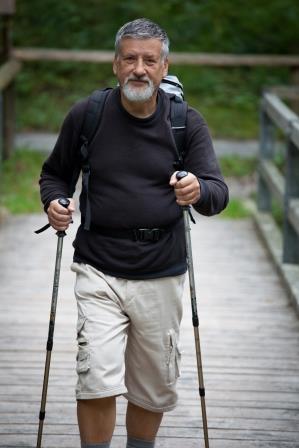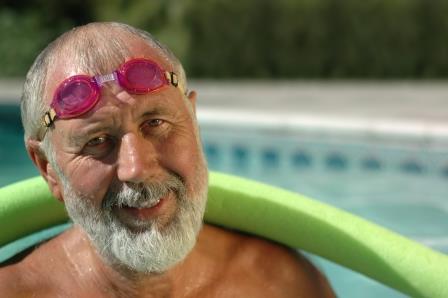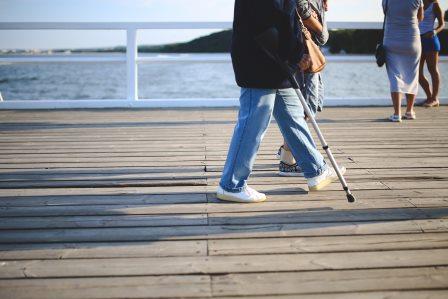Exercise and physical fitness for older people with bleeding disorders was the subject of an HFA webinar during Bleeding Disorders Awareness Week 2020. How does ageing impact on muscles and joints if you have haemophilia or VWD or other bleeding disorders? How can exercise help your body and general wellbeing? What about if you have arthritis?

Abi and Megan from the Ronald Sawers Haemophilia Centre in Melbourne and Zev, one of their patients with severe haemophilia, led a comprehensive discussion about the issues and answered questions from the audience.
Watch the video of the webinar:
Facilitator: Natashia Coco, Haemophilia Foundation Australia
Speakers:
Abi Polus, Senior Clinical Physiotherapist – Haemophilia, Ronald Sawers Haemophilia Centre, The Alfred, Melbourne
Megan Walsh, Clinical Nurse Consultant, Ronald Sawers Haemophilia Centre, The Alfred, Melbourne
Zev, who has severe haemophilia.
‘Ageing is just another word for living,’ was the way Abi Polus commenced her presentation on exercise, and making the most of life was what this webinar was all about.
Abi described herself as having ‘a passion for exercise’ and was enthusiastic about the many benefits of exercise for people with bleeding disorders.
She pointed out that after the boom years of bone and muscle cell production in our youth, we naturally enter a steady decline from the age of about 30 years. It is normal to have some change in the cartilage in joints from this age as well. In haemophilia these changes can occur a bit earlier in life, particularly if you are part of the generation who did not have prophylaxis treatment to prevent bleeds and were encouraged not to be active when you were young. Repeated bleeds into joints were also likely to lead to an early onset of arthritis.
However, getting older doesn’t mean you need to decrease exercise. Abi explained that the body adapts to the demands put on it. The physical demands of exercise can help to combat the effects ageing has on our muscles, bone and cartilage. Exercise can increase muscle mass, bone stock and lubricate joints. It can maintain the range of movement in your joints and help with balance.

Everybody has a different approach to life and an individual situation with their body. Abi’s message – exercise is a way of working with the body that you have to have the best chance of achieving what you want with your life. It is important to take on exercise that you would like to do, rather than trying to commit to something that you will never enjoy or feel motivated about.
Although people often imagine that they will need to be very fit to have benefits from exercise, Abi pointed out that exercise is very individual – and it may not require a lot of equipment. For one person going up some stairs can involve the same intensity for their body that someone else might experience in a full gym workout.
Abi discussed the barriers to exercise she hears from her patients: time, access to the gym or pool, pain, motivation. She noted that research has shown that exercise in people with haemophilia does not increase pain, it may even decrease it, and has other benefits. Arthritis studies have also shown that exercise and weight management can help to manage the pain related to arthritis.
Her top 4 tips:
A very important message: when you would like to start a new exercise program or have some goals, talk to the physiotherapist at your HTC, and they will help you with a program that will suit your individual needs and physical issues.
Megan Walsh followed Abi’s presentation with a discussion about working exercise into your life if you have a bleeding disorder.
She spoke first about the benefits of exercise for older people with bleeding disorders – physically, to keep working and enjoy relationships (for example, playing with grandchildren), and for mental health. With regular exercise, veins are larger and more elastic, muscles are more supportive of joints, bleeds do not occur as often.
Recording treatments and bleeds in the MyABDR app is an important tool for monitoring how things are going with your exercise program in an objective way: are your bleeds decreasing or increasing? Have you started doing something different, eg having some bleeds because you started gardening? You can write some notes in MyABDR to explain this to share with your HTC, as well as to keep your own diary.
This is a good time to work together with the HTC team – the nurses, doctors and physiotherapists – to review how you are exercising and the impact, so that they can suggest other ways to do things or tweak your exercise program or treatment plan if you are having bleeding problems or other issues when you are exercising. It might be that your exercise program is a little too vigorous for you. Both Megan and Abi underlined that the physiotherapist wouldn’t be upset if you said this – they would just revise your exercise program so that it worked for you. And if your HTC doesn’t have a dedicated specialist physiotherapist, it is still important to discuss your exercise program with your HTC. They can check questions with expert physiotherapists in other states and talk to the physiotherapist that you see about any bleeding disorder-related issues.
Falls and balance become more problematic as you grow older, along with the likelihood that a fall might result in a fracture. Megan encouraged older people with bleeding disorders to start seeing a physiotherapist to improve balance and strength and perhaps to consider a referral from your HTC to a community falls and balance exercise program.
Aligning your exercise program with your prophylaxis treatment plan is also important. Megan explained that you would get the most protection from your treatment for vigorous exercise when your factor levels are highest. The effect of a particular treatment on clotting factor levels is individual, i.e., when your clotting factor levels are highest and how long they remain at that level. It will be valuable to work with your HTC team to understand your treatment and factor level patterns and to manage your exercise program around it.
As you grow older, there are also practical aspects of managing your physical health. Do you have ambulance cover? Do you need help with mobility issues? What services are available? How are things at home – can they be improved, so that you don’t trip or can get around more easily? Do you need help with your eyesight? Megan highlighted that the HTC team are happy to help with working through these questions. They can also organise referrals to other health professionals, for example, an occupational therapist, or to services nearer to where you live.
Megan offered an invitation: feeling like your exercise program isn’t making a difference? Ask your HTC to show you if anything has improved. You might be surprised at what your physiotherapist has noticed and what changes they can demonstrate to you!

Keeping in touch with other people with bleeding disorders can be very supportive as you grow older and navigate your way through some of these issues. They will have grown up and lived through their adult life with similar problems and understand what it is like – the good and the bad days.
Growing up with haemophilia before there was effective treatment meant that exercise often resulted in bleeds, hospitalisation and permanent joint damage. Zev has severe haemophilia and, at 69 years of age, now has what he describes as ‘a distinctive walk’ as a result of his first 16 years without replacement factor therapy. ‘Playing sport, contact sports, running, having an exercise regime, going for a ride was just completely out of the question,’ he said.
Now he is on prophylaxis treatment with stable factor levels and appreciates being able to exercise, to the degree that he can. He goes for walks and, although he can’t play golf anymore because of elbow problems, he goes in the golf buggy with his mates to enjoy the social interaction. With one fused knee and an above-knee amputation on the other leg, exercise is a little more challenging. He has worked out that he can use an exercise bike and exercise his arms on the bike as well, which is great for a cardiovascular workout. Although he doesn’t enjoy walking, he pushes himself: he has found an oval with a flat and even turf that he can walk around safely, and can increase the amount that he walks to improve his fitness.
Working with a physiotherapist has meant that he has an exercise program that works for him. Motivating himself to exercise has been part of his challenge. He makes arrangements to attend hydrotherapy with other mates who have haemophilia so that he is less likely to cancel – ‘I would feel like I was letting them down.’
The session finished with a Q & A panel discussion, with questions from the audience.
Tips for what would motivate people to exercise?
What do you do when you have pain with exercise?
What can you do when you have a fused knee?
Thanks to Abi, Megan and Zev for an informative and interesting session!
If you would like more information about an exercise program for you, speak to your Haemophilia Treatment Centre. Contact details of HTCs are on the HFA website.
You can find more information about exercise, along with the full video of this session, under HEALTH AND WELLBEING on the HFA Getting Older Info Hub.
Haemophilia Foundation Australia acknowledges the Traditional Owners and Custodians of Country throughout Australia, the land, waters and community where we walk, live, meet and work. We pay our respects to Elders past and present and extend that respect to all Aboriginal and Torres Strait Islander peoples.
Sign up for the latest news, events and our free National Haemophilia magazine